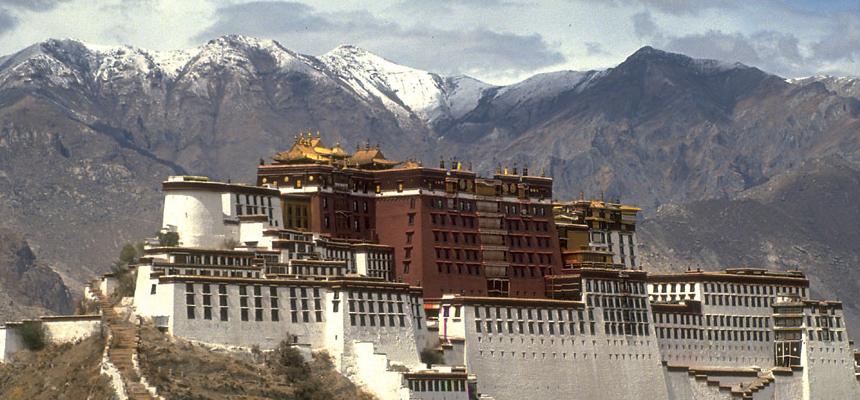Lhasa in Tibetan means “lands of God” and has been the center of politics, economy, culture and religion in the Tibet Autonomous Region since ancient times. It is located on the north bank of the Kyichu river, a tributary of the Yarlung Tsangpo River, at an altitude of 3650 meters above sea level. Lhasa has a history dating back over 1300 years and its many attractions are described below.
Potala Palace
The Potala, one of the most famous architectural works in the world, sits on top of the Red Hill in Lhasa. Constructed In the 7th century, after the Tibetan King Songtsen Gampo’s married Princess Wencheng of the Tang Court, the Palace was built to provide the Tibetan court with a place for worship and meditation. In the mid-17th century, it was extended by the 5th Dalai Lama to its present size, and became the Winter Palace of the Dalai Lamas. The construction took fifty years from commencing to completion.
The Potala is divided into two sections, namely, the Red Palace and White Palace. The total height of the Potala is 117 meters spanning thirteen story’s. The length from east to west is 400 meters and the breadth from south to north is 350 meters. The building is constructed of stone and timber with golden roofs. It is a majestic architectural masterpiece.
Norbulingkha (The summer Palace of the Dalai Lama):
The name Norbulinka means “Jeweled Garden,” a fitting title for this 200 year old park, stretching over 360,000 sq. m. The 370 room summer palace of the Dalai Lama is located inside the park at Lhasa and was constructed in 1755. During the following years more and more structures were added like chapels, gardens, fountains and pools with the most important contribution by the 14th Dalai Lama. His palace is also the most visited one and has a modern touch and a mixed style of architecture and interiors. In 2001, UNESCO inscribed Norbulingka on its World Heritage List as part of the “Historic Ensemble of the Potala Palace”.
The Three Great Monasteries or “Three Pillars of Buddhism”
Sera Monastery, Ganden Monastery and Drepung Monastery in Lhasa are known as the “Three Great Monasteries” of Tibet or the “Three Pillars of Buddhism”. They functioned as monastic universities providing religious education to the monks.
Sera monastery
Sera means “hailstone” or “rose” in Tibetan and has two legends about the origin of its name. The first one tells us that it was hailing during the construction while the second one says that the hill behind it was covered with wild roses in bloom. The monastery is set at the foot of the Wudu Hill and situated to the north of Lhasa. Sera Monastery was founded in 1419 by Jamchen Choje, a disciple of Tsongkapa, the founder of the Gelugpa Sect. Its main buildings are the Coqen Hall, Zhacang (college) and Kamcun (dormitory).
Drepung monastery
Situated five kilometers west of Lhasa at the foot of Mt. Ganpoi Uze. The Drepung Monastery was founded in 1416 by Jamchen Choje, a disciple of Tsongkapa, the founder of Gelugpa Sect. The Monastery occupying an area of 250,000 square meters maintains a fixed number of 7,700 monks and is the largest monastery in Tibet. The Monastery keeps many historical relics, Buddhist scriptures, arts, and crafts.
Ganden Monastery
Tsong Khapa founded this Monastery, the first Gelukpa Monastery, in 1490 on one of the most spectacular sites in Tibet, about 50 km east of Lhasa near Dagze. Work has begun to restore the damage wreaked by the Chinese Cultural Revolution. So, extensive is the damage, one might easily think Ganden had been subjected to saturation aerial bombardment. The four main temples now house about 200 monks, who were the remnants of a population that once exceeded 4000. The views from Ganden, down into the Kyichu valley and across to the distant snowcaps, are quite exceptional.
Jokhang Temple:
Jokhang Temple:
The Jokhang Temple, situated in the center of old Lhasa, was built in the mid-7th century. It was later extended by successive rulers, and has now become a gigantic architectural complex. Located in the east of the city, Jokhang is a four storied Temple with splendid golden roofs. Its architectural features art from the Tang Dynasty but it has also assimilated many features from both Nepalese and Indian Buddhist Temples. The murals in the temple depict the life stories of historic and religious characters. The temple houses many historical relics, including statues of King Songtsen Gompo, Princess Wencheng, Princess Bhrikuti Devi (Nepalese), “Princess Willow” (a tree), and “The Uncle-Nephew Alliance Tablet.” Jokhang is Tibet’ s spiritual center, and the holiest destination for Tibetan Buddhist pilgrims. It houses a sitting statue of Sakyamuni when he was 12 years old.
Barkhor Square:
Barkhor Square:
This is Lhasa’s inner pilgrim circuit, shaped roughly like an octagon, which runs around the Jokhang temple. The circuit is lined with markets, shops stalls and street vendors providing every, conceivable item a Tibetan could need a very good place to sample Tibetan barley beer. This is a very holy pilgrimage site for Tibetans who come from all over to experience the unique atmosphere.


Comments